Books & Bookstores
Teaching
with Mind and Heart: Affect in the Restorative
School
[eBook]
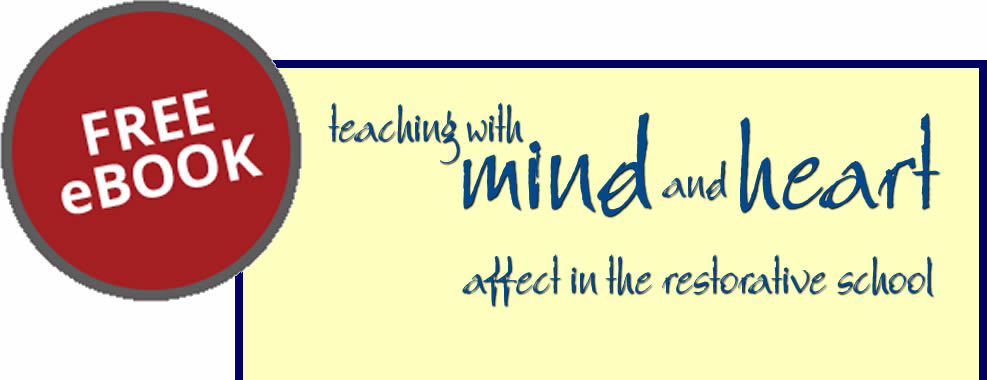 George, GB. [2016] This free eBook outlines how the insights of affect script psychology can have direct, immediate application to the moral, emotional work of teachers in schools, both in the area of behaviour and relationship management through restorative practices, and in the teaching and learning process in the classroom. Download the free eBook here |
Books (including
other free eBooks)
I can recommend each of the following
books. I have found each of them useful in the school context. Please note
that I have no financial interest in any of these publications.
- Implementing Restorative Practices in Schools: A Practical Guide to Transforming School Communities. Marg Thorsborne & Peta Blood, 2013 via the Book Depository
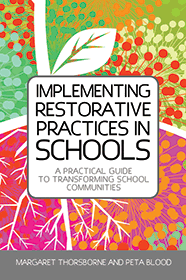 Implementing
Restorative Practices in Schools explains what has to happen in a
school in order for it to become truly restorative.
Implementing
Restorative Practices in Schools explains what has to happen in a
school in order for it to become truly restorative.
Section 1 explains the potential of
restorative practice in schools, describing the positive outcomes for
students and teachers. It also outlines the measures that need to be in
place in order to embed restorative practice.
Section 2
examines the process of understanding and managing change, providing
realistic and pragmatic guidance on the practical and emotional barriers
that may be encountered.
Finally, Section 3
provides in eight practical steps, strategic guidance for achieving a
restorative culture that sticks.
Featuring useful pro formas and
templates, this book will be an indispensable guide for educators,
administrators and school leaders in mainstream and specialist settings.
-
A Practical Introduction to Restorative Practice in Schools: Theory, Skills and Guidance. Bill Hansberry, 2016 JKP via Amazon
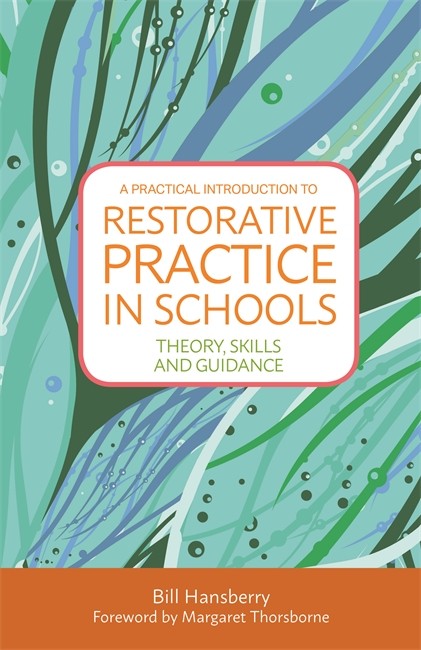 Proven
to reduce bad behaviour and exclusions, and encourage
happier, safer school environments, restorative justice
is an effective approach to conflict resolution.
Proven
to reduce bad behaviour and exclusions, and encourage
happier, safer school environments, restorative justice
is an effective approach to conflict resolution.
Suitable for education settings from preschool to college, this guide explains what restorative justice is, how it can be used in schools, what it looks like in the classroom and how it can be implemented. Featuring case studies that illuminate the underlying restorative principles and practices, this book covers a wide range of topics from the basics of restorative justice, through to school-wide processes for embedding the approach in policy and practice.
Drawing on the expertise of educators and consultants, this is a must-have resource for any school or centre that is serious about reducing bad behaviour and developing safer learning communities.
- The Psychology of Emotion in Restorative Practice: How Affect Script Psychology Explains How and Why Restorative Practice Works. Vernon Kelly & Marg Thorsborne (Eds), 2014 - via the Book Depository
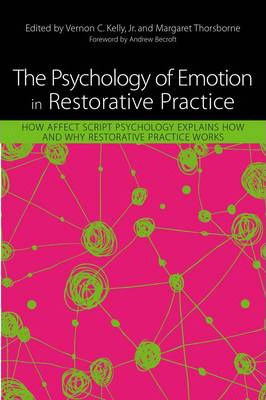 How
and why does restorative practice (RP) work? This book presents the
biological theory, affect script psychology (ASP), behind RP, and shows
how it works in practice in different settings. ASP explains how the
central nervous system triggers 'affects' which are the basis of all
human motivation and emotion. The book presents a clear explanation of
what ASP is, how it relates to RP, and how ASP helps practitioners to
understand relationships, emotions and dynamics in their work. The
chapters are based around case studies which demonstrate RP in criminal
justice, organizational and education settings. They show how theory
links to practice, and how having a deep understanding of the theory has
helped practitioners to be successful in their work. Providing an
accessible explanation of how RP works, this book will be invaluable to
all RP practitioners in any setting, as well as RP students and
academics.
How
and why does restorative practice (RP) work? This book presents the
biological theory, affect script psychology (ASP), behind RP, and shows
how it works in practice in different settings. ASP explains how the
central nervous system triggers 'affects' which are the basis of all
human motivation and emotion. The book presents a clear explanation of
what ASP is, how it relates to RP, and how ASP helps practitioners to
understand relationships, emotions and dynamics in their work. The
chapters are based around case studies which demonstrate RP in criminal
justice, organizational and education settings. They show how theory
links to practice, and how having a deep understanding of the theory has
helped practitioners to be successful in their work. Providing an
accessible explanation of how RP works, this book will be invaluable to
all RP practitioners in any setting, as well as RP students and
academics.
Section 1. The Theory Underpinning Restorative Justice.
1. Caring, Restorative Practice and the Biology
of Emotion. Vernon C. Kelly, Jr
2. Interpersonal
Caring, Social Disciple and a Blueprint for Restorative Healing. Vernon
C. Kelly, Jr
Section 2. The Theory in Action in Communities
and the Criminal Justice System.
3.
Being Emotional, Being Human: Creating Healthy Communities and
Institutions by Honoring our Biology. Lauren Abramson
4. Restorative Practice in a Policing Environment: Understanding Affect
Will Help. John Lennox
5. Forgiveness. Katy
Hutchison
6. A Necessary Discovery: Why the
Theory is Important. Matthew Casey, Bill Curry, Anne Burton, Katherine
Gribben
Section 3. The Theory in Action in Organizational
Settings.
7. Keep Calm and Carry On:
From Fear to Fun Over Two Years in a British Youth Arts Organization.
Sian Williams
8. Drama Queens. Margaret
Thorsborne
Section 4. The Theory in Action in Education.
9. Affect and Emotion in a Restorative School.
Graeme George
10. They Suck, School Sucks, I Suck:
The Secret Emotional Life of a Child with a Brain that Learns
Differently. Bill Hansberry
- Restorative Justice: Pocketbook. Thorsborne, M. & Vinegrad, D. Teachers' Pocketbooks 2009. Amazon
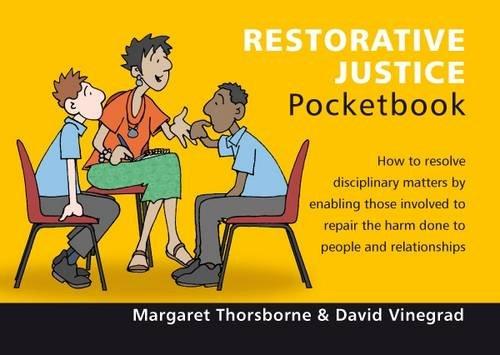 From the
publisher: Schools that have adopted the ancient principles
of restorative justice in their approach to behaviour management report
better relationships with young people, greater engagement in learning and a
greater development of social and emotional competence among learners. No
surprise, then, that interest in restorative practices is growing. It’s all
about relationships. Wrongdoing is viewed through a ‘relational lens’. All
those responsible for and affected by the behaviour are involved in solving
the problem. Working in conference with a teacher/facilitator, participants
come to understand the harm done to people and relationships. Accepting that
such harm creates obligations and liabilities, they then focus on repairing
the damage and putting things right.
From the
publisher: Schools that have adopted the ancient principles
of restorative justice in their approach to behaviour management report
better relationships with young people, greater engagement in learning and a
greater development of social and emotional competence among learners. No
surprise, then, that interest in restorative practices is growing. It’s all
about relationships. Wrongdoing is viewed through a ‘relational lens’. All
those responsible for and affected by the behaviour are involved in solving
the problem. Working in conference with a teacher/facilitator, participants
come to understand the harm done to people and relationships. Accepting that
such harm creates obligations and liabilities, they then focus on repairing
the damage and putting things right.
- The Restorative Classroom: Using Restorative Approaches to Foster Effective Learning. Hopkins, B. Optimus Education. 2011 Optimus Education
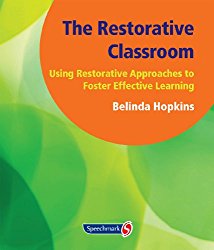 From the publisher:
"Restorative approaches are about more than just repairing relationships
when things go wrong, they are also about making and maintaining
relationships and they inform a style of teaching just as much as they do an
approach to problem solving and conflict resolution. By giving everyone a
voice, considering everyone’s thoughts, feelings and needs and believing in
people’s ability to find solutions to their own problems by working
together, young people will develop the language and skills they need to
properly engage with their peers.The Restorative Classroom invites classroom
teachers and teaching assistants to reflect on themselves, on their role,
their purpose and their intention in the classroom and on their current
style of engagement with their students. It combines a focus on the making,
maintaining and repairing of relationships in the classroom with the
development of social responsibility and a mutually supportive learning
community in that classroom."
From the publisher:
"Restorative approaches are about more than just repairing relationships
when things go wrong, they are also about making and maintaining
relationships and they inform a style of teaching just as much as they do an
approach to problem solving and conflict resolution. By giving everyone a
voice, considering everyone’s thoughts, feelings and needs and believing in
people’s ability to find solutions to their own problems by working
together, young people will develop the language and skills they need to
properly engage with their peers.The Restorative Classroom invites classroom
teachers and teaching assistants to reflect on themselves, on their role,
their purpose and their intention in the classroom and on their current
style of engagement with their students. It combines a focus on the making,
maintaining and repairing of relationships in the classroom with the
development of social responsibility and a mutually supportive learning
community in that classroom."
- Circle in the Square: Building Community and Repairing Harm in School. Riestenberg, N. Living Justice Press 2012 Living Justice
 From the
publisher: "In this, her first book, Nancy
Riestenberg writes warmly and with long experience about the challenges
facing school communities and how restorative measures—specifically
Circles—create a safer space for learning and development for all. Using
stories direct “from the hallways,” she brings heart to subjects that are
often divisive and controversial: bullying and other violence, suspension,
drug use, staff conflicts, and more. Throughout the book, Nancy’s focus is
on strategies that actually work for the whole school community: students,
parents, administrators, teachers, and the community in which they live."
From the
publisher: "In this, her first book, Nancy
Riestenberg writes warmly and with long experience about the challenges
facing school communities and how restorative measures—specifically
Circles—create a safer space for learning and development for all. Using
stories direct “from the hallways,” she brings heart to subjects that are
often divisive and controversial: bullying and other violence, suspension,
drug use, staff conflicts, and more. Throughout the book, Nancy’s focus is
on strategies that actually work for the whole school community: students,
parents, administrators, teachers, and the community in which they live."
- Working Restoratively in Schools: A Guidebook for Developing Safe & Connected Learning Communities. Hansberry, B. Inyahead Press
 From the publisher:
"Working Restoratively in Schools has been written
with an understanding of on-the-ground school discipline from a classroom
and school administration level. Suitable from Kindy to Secondary, this
guidebook addresses many of the questions that schools have about the
ongoing and sustainable implementation of Restorative Justice (RJ). Divided
into 4 sections, this guidebook covers a wide range of topics from the
basics of RJ, through to school-wide processes for embedding RJ in policy
and practice. Written by Bill Hansberry - a classroom teacher and
consultant, and drawing on the expertise of other well respected educators
and consultants, this is a must-have resource for any school or centre that
is serious about developing safer and more connected learning communities."
From the publisher:
"Working Restoratively in Schools has been written
with an understanding of on-the-ground school discipline from a classroom
and school administration level. Suitable from Kindy to Secondary, this
guidebook addresses many of the questions that schools have about the
ongoing and sustainable implementation of Restorative Justice (RJ). Divided
into 4 sections, this guidebook covers a wide range of topics from the
basics of RJ, through to school-wide processes for embedding RJ in policy
and practice. Written by Bill Hansberry - a classroom teacher and
consultant, and drawing on the expertise of other well respected educators
and consultants, this is a must-have resource for any school or centre that
is serious about developing safer and more connected learning communities."
- The Restorative Practices Handbook: for Teachers, Disciplinarians and Administrators. Costello, B., Wachtel, J. & Wachtel, T. International Institute for Restorative Practices (IIRP) Bethlehem Pa. 2009 IIRP
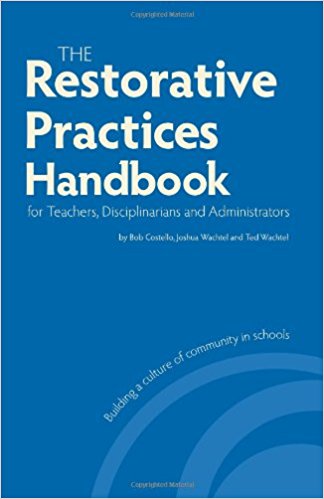 From the publisher:
"The Restorative Practices Handbook is a practical guide for
educators interested in implementing restorative practices, an approach that
proactively builds positive school communities while dramatically reducing
discipline referrals, suspensions and expulsions. The handbook discusses the
spectrum of restorative techniques, offers implementation guidelines,
explains how and why the processes work, and relates real-world stories of
restorative practices in action."
From the publisher:
"The Restorative Practices Handbook is a practical guide for
educators interested in implementing restorative practices, an approach that
proactively builds positive school communities while dramatically reducing
discipline referrals, suspensions and expulsions. The handbook discusses the
spectrum of restorative techniques, offers implementation guidelines,
explains how and why the processes work, and relates real-world stories of
restorative practices in action."
- Restorative Practices in Schools: Rethinking Behaviour Management. Thorsborne, M. & Vinegrad, D. Inyahead Press. 2006 Inyahead Press
 From the publisher:
"A 'just' school is a place where victims and offenders and their
respective communities of care are active participants in processes that
ensure equal justice and fairness. Victims are empowered to have their needs
met and to have their experience validated. Offenders are able to tell their
stories and be given the chance to make amends. And finally, the community
of care may seek ways to ensure that the incident does not happen again.
This book takes you through the restorative practice process with chapters
on: deciding whether to conference or not, conference preparation, convening
the conference, managing the emotional dynamics, what if? Appendices and
case studies."
From the publisher:
"A 'just' school is a place where victims and offenders and their
respective communities of care are active participants in processes that
ensure equal justice and fairness. Victims are empowered to have their needs
met and to have their experience validated. Offenders are able to tell their
stories and be given the chance to make amends. And finally, the community
of care may seek ways to ensure that the incident does not happen again.
This book takes you through the restorative practice process with chapters
on: deciding whether to conference or not, conference preparation, convening
the conference, managing the emotional dynamics, what if? Appendices and
case studies."
- Restorative Practices in Classrooms: Rethinking Behaviour Management. Thorsborne, M. & Vinegrad, D. Inyahead Press. 2006 Inyahead Press
 From the publisher:
"Based on the
Restorative Practices philosophy, this book shows
how the approach may be applied to classroom practice. Chapters include:
working proactively; classroom conferences; individual, small and medium
group conferences; facilitating conferences; what if? Appendices include:
classroom script; the No Blame conference script; classroom conference
report; classroom conference evaluation; letters to parents; case studies
and recommended reading."
From the publisher:
"Based on the
Restorative Practices philosophy, this book shows
how the approach may be applied to classroom practice. Chapters include:
working proactively; classroom conferences; individual, small and medium
group conferences; facilitating conferences; what if? Appendices include:
classroom script; the No Blame conference script; classroom conference
report; classroom conference evaluation; letters to parents; case studies
and recommended reading."
- Restorative Practices and Bullying: Rethinking Behaviour Management. Thorsborne, M. & Vinegrad, D. Inyahead Press. 2006 Inyahead Press
-
 From the publisher:
"This book is the
third in the school series of books on Restorative Justice. The guiding
principles of restorative justice provide for a different response to
bullying. When harm is done (deliberate or otherwise) it needs to be fixed.
These principles are not based on definitions of bullying behaviour or
measure of frequency and intensity. The authors believe that can bring about
repair and healing, and in the long term, make the school a safer place."
From the publisher:
"This book is the
third in the school series of books on Restorative Justice. The guiding
principles of restorative justice provide for a different response to
bullying. When harm is done (deliberate or otherwise) it needs to be fixed.
These principles are not based on definitions of bullying behaviour or
measure of frequency and intensity. The authors believe that can bring about
repair and healing, and in the long term, make the school a safer place."
- Restorative Justice and Civil Society. Strang, H & Braithwaite, J. Cambridge University Press, Cambridge 2001 Amazon.com
 From the
publisher: "Advocates of
restorative justice question the state's ability to deliver satisfactory
justice. This provocative volume looks at the flourishing restorative
justice movement and considers the relationship between restorative justice
and civil society. Genuinely international, it addresses aspects of civil
society including schools, families, churches and private workplaces and
considers broader issues such as democracy, human rights, access and equity.
It presents the ideals of restorative justice so that victims, offenders,
their families and communities might have more representation in the justice
process."
From the
publisher: "Advocates of
restorative justice question the state's ability to deliver satisfactory
justice. This provocative volume looks at the flourishing restorative
justice movement and considers the relationship between restorative justice
and civil society. Genuinely international, it addresses aspects of civil
society including schools, families, churches and private workplaces and
considers broader issues such as democracy, human rights, access and equity.
It presents the ideals of restorative justice so that victims, offenders,
their families and communities might have more representation in the justice
process."
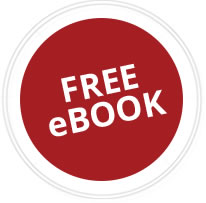
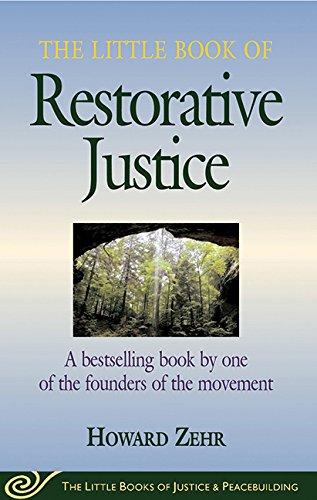 From the
publisher: “The Little Book of
Restorative Justice is for those who have heard the term and are curious
about what it implies and for those who are involved in the field but are
becoming unclear or losing track of what they are trying to do. I hope to
help bring clarity about where the restorative justice ‘train’ is heading
and, in some cases, to nudge the train back onto the track.”
From the
publisher: “The Little Book of
Restorative Justice is for those who have heard the term and are curious
about what it implies and for those who are involved in the field but are
becoming unclear or losing track of what they are trying to do. I hope to
help bring clarity about where the restorative justice ‘train’ is heading
and, in some cases, to nudge the train back onto the track.”

 From the
publisher: "Although written
without knowledge of the conferencing process, Australian criminologist John
Braithwaite's book Crime, Shame and Reintegration provides a sociological
explanation for why conferencing works so well. Braithwaite explains that
the desire to avoid shame aids in the development of conscience and social
bonds. He distinguishes between two types of shame: stigmatizing shame which
rejects and permanently labels offenders and reintegrative shame which only
rejects the offender's deed but not the offender himself.
From the
publisher: "Although written
without knowledge of the conferencing process, Australian criminologist John
Braithwaite's book Crime, Shame and Reintegration provides a sociological
explanation for why conferencing works so well. Braithwaite explains that
the desire to avoid shame aids in the development of conscience and social
bonds. He distinguishes between two types of shame: stigmatizing shame which
rejects and permanently labels offenders and reintegrative shame which only
rejects the offender's deed but not the offender himself.
- Safer Saner Schools. Mirsky, L. & Wachtel, T. The Piper's Press, Pipersville, PA. 1997 IIRP
 From the
publisher: "This collection of
articles from the Restorative Practices eForum - the IIRP's internet
publication with thousands of subscribers around the world - conveys the
power of restorative practices to transform schools into positive, vibrant
communities while dramatically reducing discipline referrals, detentions and
suspensions. The articles include accounts of personal experiences,
implementation and research in schools from the United States and Canada to
the United Kingdom, Europe, Australia and Asia."
From the
publisher: "This collection of
articles from the Restorative Practices eForum - the IIRP's internet
publication with thousands of subscribers around the world - conveys the
power of restorative practices to transform schools into positive, vibrant
communities while dramatically reducing discipline referrals, detentions and
suspensions. The articles include accounts of personal experiences,
implementation and research in schools from the United States and Canada to
the United Kingdom, Europe, Australia and Asia."
- Shame and Pride: Affect, Sex and the Birth of the Self. Nathanson, D.L. W W Norton and Co, New York. 1992 Amazon
 From the
publisher: "Donald Nathanson' book
provides the psychological explanation for why conferencing works. A
Philadelphia psychiatrist, author and lecturer, he wrote Shame and Pride
before he was aware of conferencing, explaining and building upon the affect
and script theories of the late Silvan S. Tomkins. Nathanson has become an
advocate of conferencing. When a crime is committed, Nathanson said in an
interview, everyone involved experiences very extreme negative affect, but
the court process fails to address this. Conferences, on the other hand,
allow for the free expression of affect, which helps people move beyond the
negative to the positive and deal with the adverse emotional consequences of
the crime."
From the
publisher: "Donald Nathanson' book
provides the psychological explanation for why conferencing works. A
Philadelphia psychiatrist, author and lecturer, he wrote Shame and Pride
before he was aware of conferencing, explaining and building upon the affect
and script theories of the late Silvan S. Tomkins. Nathanson has become an
advocate of conferencing. When a crime is committed, Nathanson said in an
interview, everyone involved experiences very extreme negative affect, but
the court process fails to address this. Conferences, on the other hand,
allow for the free expression of affect, which helps people move beyond the
negative to the positive and deal with the adverse emotional consequences of
the crime."
-
The Art of Intimacy and the Hidden Challenge of Shame, Kelly, V. Tomkins Press 2012 Amazon
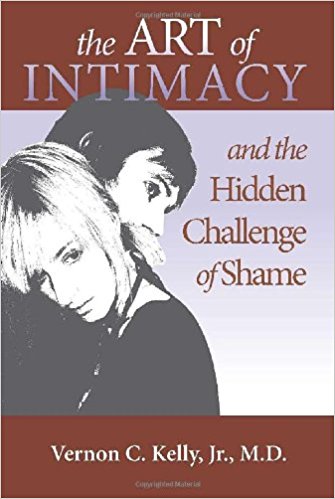 Kelly
makes himself accessible in the process of teaching. His
open manner and wise voice help readers to see the
unseeable and speak the unspeakable-to deal with their
shame. He guides couples to use their shame instead of
fearing it. The result is resilience-both individually
and relationally. This book will benefit every couple;
it should be required reading for engaging in
relationships. -DON R. CATHERALL, PH.D., Professor of
Clinical Psychiatry and Behavioral Sciences, Feinberg
School of Medicine, Northwestern University; Author of
Emotional Safety: Viewing Couples Through the Lens of
Affect (Routledge, 2007).
Kelly
makes himself accessible in the process of teaching. His
open manner and wise voice help readers to see the
unseeable and speak the unspeakable-to deal with their
shame. He guides couples to use their shame instead of
fearing it. The result is resilience-both individually
and relationally. This book will benefit every couple;
it should be required reading for engaging in
relationships. -DON R. CATHERALL, PH.D., Professor of
Clinical Psychiatry and Behavioral Sciences, Feinberg
School of Medicine, Northwestern University; Author of
Emotional Safety: Viewing Couples Through the Lens of
Affect (Routledge, 2007).
-
The Upside of Shame: Therapeutic Interventions Using the Positive Aspects of a "Negative" Emotion. Kelly, V & Lamia, M. Norton & Company 2018 Amazon
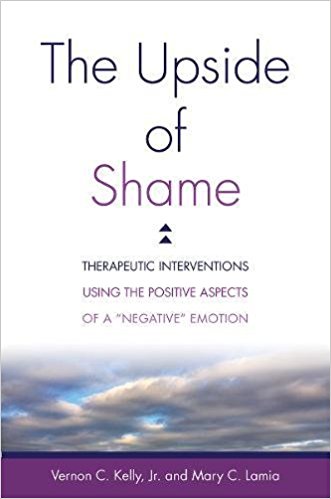 Understanding
shame as a signal that things we enjoy are being
impeded.
Understanding
shame as a signal that things we enjoy are being
impeded.
- Conferencing Handbook. The New REAL Justice Training Manual. O'Connell, T., Wachtel, B., Wachtel, T. The Piper's Press, Pipersville, PA. 1999 IIRP
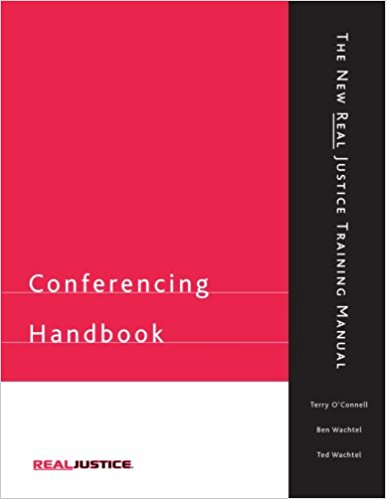 From the
publisher: "A procedural guide
to coordinating and facilitating restorative conferences, structured
meetings between offenders, victims and both parties’ family and friends, in
which they deal with the consequences of the offense and decide how best to
repair the harm. The handbook covers the process of selecting cases,
inviting participants, making preparations and running the conference
itself. It is useful to anyone who wants to learn to facilitate conferences
in school, criminal justice and other settings. Originally published in
1999."
From the
publisher: "A procedural guide
to coordinating and facilitating restorative conferences, structured
meetings between offenders, victims and both parties’ family and friends, in
which they deal with the consequences of the offense and decide how best to
repair the harm. The handbook covers the process of selecting cases,
inviting participants, making preparations and running the conference
itself. It is useful to anyone who wants to learn to facilitate conferences
in school, criminal justice and other settings. Originally published in
1999."
- New Directions in Restorative Justice: Issues, Practice, Evaluation. Elliott, E. and Gordon, R. M. (Eds) Willan Publishing, Devon. 2005. Amazon.com
 From the publisher:
"This book addresses a number of key themes and
developments in restorative justice, and is based on papers originally
presented at the 6th International Conference on Restorative Justice in
Vancouver. It is concerned with several new areas of practice within
restorative justice, with sections on restorative justice and youth,
aboriginal justice and restorative justice, victimization and restorative
justice, and evaluating restorative justice. Contributors to the book are
drawn from leading experts in the field from the UK, US, Europe, Canada,
Australia and New Zealand."
From the publisher:
"This book addresses a number of key themes and
developments in restorative justice, and is based on papers originally
presented at the 6th International Conference on Restorative Justice in
Vancouver. It is concerned with several new areas of practice within
restorative justice, with sections on restorative justice and youth,
aboriginal justice and restorative justice, victimization and restorative
justice, and evaluating restorative justice. Contributors to the book are
drawn from leading experts in the field from the UK, US, Europe, Canada,
Australia and New Zealand."
- Restorative Practices for Schools: A Resource. The Restorative Practices Development Team, School of Education, University of Waikato. 2003. Waikato University

 From the
publisher: "This Kete
(resource booklet) is a response to the interest shown by colleagues in
schools in New Zealand, as well as by colleagues internationally, in the
foundational work we at the University of Waikato School of Education did in
restorative conferencing and restorative practices in schools in the early
2000s. This Kete was prepared with a view to informing those who may be
considering introducing the practices into their school. It gives an
overview of the philosophy of restorative practice, describes the process of
restorative conversation (including formal conferencing), and offers
recommendations about things to consider in introducing the practices into
schools. The Kete contains resources that can be used to guide the
development of understanding and facilitation of restorative conversations.
We offer you these resources in the hope that they will help you forward
your own work on developing practices of respect in your school."
From the
publisher: "This Kete
(resource booklet) is a response to the interest shown by colleagues in
schools in New Zealand, as well as by colleagues internationally, in the
foundational work we at the University of Waikato School of Education did in
restorative conferencing and restorative practices in schools in the early
2000s. This Kete was prepared with a view to informing those who may be
considering introducing the practices into their school. It gives an
overview of the philosophy of restorative practice, describes the process of
restorative conversation (including formal conferencing), and offers
recommendations about things to consider in introducing the practices into
schools. The Kete contains resources that can be used to guide the
development of understanding and facilitation of restorative conversations.
We offer you these resources in the hope that they will help you forward
your own work on developing practices of respect in your school."
- Just Schools: A Whole School Approach to Restorative Justice. Hopkins, B. Jessica Kingsley Publishers, London. 2004. Amazon
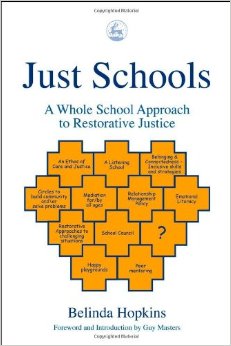 From the
publisher: "From a teaching
background herself, Belinda Hopkins is at the forefront of the development
of restorative justice in the UK, and in this practical handbook she
presents a whole school approach to repairing harm using a variety of means
including peer mediation, healing circles and conference circles. She
provides clear, practical guidance for group sessions and examines issues
and ideas relating to practical skill development for facilitators. Clearly
structured and with photocopiable sheets, this book is an excellent resource
for teachers, school counsellors and youth workers seeking a more positive
and effective way to deal with conflict in educational settings."
From the
publisher: "From a teaching
background herself, Belinda Hopkins is at the forefront of the development
of restorative justice in the UK, and in this practical handbook she
presents a whole school approach to repairing harm using a variety of means
including peer mediation, healing circles and conference circles. She
provides clear, practical guidance for group sessions and examines issues
and ideas relating to practical skill development for facilitators. Clearly
structured and with photocopiable sheets, this book is an excellent resource
for teachers, school counsellors and youth workers seeking a more positive
and effective way to deal with conflict in educational settings."
- Restoring Safe School Communities. Morrison, B. The Federation Press, Leichhardt NSW 2007. Federation Press
 From the
publisher: "This book introduces a
whole school approach to addressing the problems of bullying and violence in
schools. Author Brenda Morrison proposes a continuum of responsive and
restorative practices for building safe school communities. The first, most
proactive, level of practices aims to develop all students’ social and
emotional competencies, to enable students to resolve their differences in
caring and respectful ways. The second level of practices widens the circle
of care around the participants. Typically this level of response occurs
when the problem has become more protracted or has involved (and affected) a
larger number of people, and involves other members of the school community
stepping in to assist in the resolution of the conflict or concern. The
third and final level of practices involves the participation of an even
wider cross-section of the school community, including parents, guardians,
social workers, and others who have been affected. This tertiary level of
intervention is normally only used for serious incidents within the school.
Morrison explains the thinking behind the suggested responses and shows how
they can be implemented by practices such as a responsible citizen program
and restorative justice circles and conferences."
From the
publisher: "This book introduces a
whole school approach to addressing the problems of bullying and violence in
schools. Author Brenda Morrison proposes a continuum of responsive and
restorative practices for building safe school communities. The first, most
proactive, level of practices aims to develop all students’ social and
emotional competencies, to enable students to resolve their differences in
caring and respectful ways. The second level of practices widens the circle
of care around the participants. Typically this level of response occurs
when the problem has become more protracted or has involved (and affected) a
larger number of people, and involves other members of the school community
stepping in to assist in the resolution of the conflict or concern. The
third and final level of practices involves the participation of an even
wider cross-section of the school community, including parents, guardians,
social workers, and others who have been affected. This tertiary level of
intervention is normally only used for serious incidents within the school.
Morrison explains the thinking behind the suggested responses and shows how
they can be implemented by practices such as a responsible citizen program
and restorative justice circles and conferences."
- Shame and Guilt. Tangney, JP & Dearing, RL, Guilford Press, New York 2002 The Book Depository
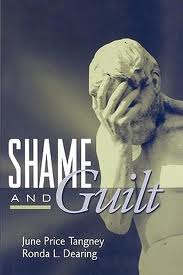 From the
publisher: "Shame and guilt have
captured the attention of scholars and clinicians for generations, but have
only recently begun to be subjected to systematic empirical scrutiny. This
book reports on the growing body of knowledge on these key self-conscious
emotions, integrating findings from the authors' original research program
with other data emerging from clinical, social, personality, and
developmental psychology. The authors demonstrate that shame and guilt have
significant-and surprisingly disparate-implications for many aspects of
human functioning, with particular relevance for interpersonal
relationships. The book examines such compelling topics as the varying
levels of empathy shown by "shame-prone" and "guilt-prone" individuals;
links to anger, hostility, and aggression; and effects of shame and guilt on
psychological adaptation and moral behavior. Clinical applications of the
research are discussed in depth, as are methodological and assessment
issues; developmental considerations; and implications for parenting,
education, and social policy."
From the
publisher: "Shame and guilt have
captured the attention of scholars and clinicians for generations, but have
only recently begun to be subjected to systematic empirical scrutiny. This
book reports on the growing body of knowledge on these key self-conscious
emotions, integrating findings from the authors' original research program
with other data emerging from clinical, social, personality, and
developmental psychology. The authors demonstrate that shame and guilt have
significant-and surprisingly disparate-implications for many aspects of
human functioning, with particular relevance for interpersonal
relationships. The book examines such compelling topics as the varying
levels of empathy shown by "shame-prone" and "guilt-prone" individuals;
links to anger, hostility, and aggression; and effects of shame and guilt on
psychological adaptation and moral behavior. Clinical applications of the
research are discussed in depth, as are methodological and assessment
issues; developmental considerations; and implications for parenting,
education, and social policy."
- Affect Imagery Consciousness The Complete Edition Tomkins, S.S. Springer Publishing Co, New York. The Book Depository
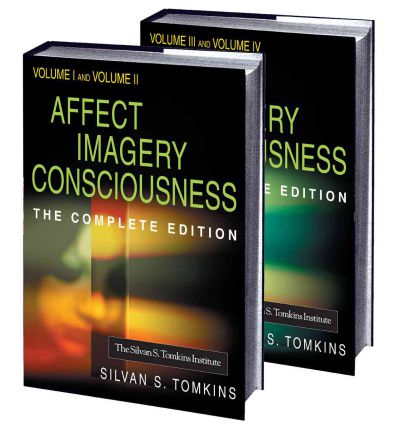 From the
publisher: "Silvan S. Tomkins was
indeed one of history's most original psychologists, a tireless scientist
who contributed much to that discipline. "Affect Imagery Consciousness" was
his life's work and consumed him from the mid 1950s through the end of his
life in 1991. With this book, he took on an enormous task; he sought to
explore emotions, or affects, why we had them, why we paid attention to
them, and how they motivated us to respond to situations in our daily
lives.Tomkins believed that "all life is 'affective life,' all behavior,
thought, planning, wishing, doing...there is no moment when we are free from
affect, no situation in which affect is unimportant." He identified nine
innate affects that humans possess, and from these, discovered a set of four
highly specific behavioral requirements known as "The Tomkins Blueprint for
Individual Mental Health", which states: as humans, we are motivated to
savor and maximize positive affect. We enjoy what feels good and do what we
can to find and maintain more of it; we are inherently biased to minimize
negative affect; the system works best when we express all of our affects;
and, anything that increases our power to accomplish these goals is good for
mental health, anything that reduces this power is bad for mental
health.These nine affects and this blueprint serve as a foundation for much
of Tomkins' research and theories discussed in the volumes of "Affect
Imagery Consciousness".
From the
publisher: "Silvan S. Tomkins was
indeed one of history's most original psychologists, a tireless scientist
who contributed much to that discipline. "Affect Imagery Consciousness" was
his life's work and consumed him from the mid 1950s through the end of his
life in 1991. With this book, he took on an enormous task; he sought to
explore emotions, or affects, why we had them, why we paid attention to
them, and how they motivated us to respond to situations in our daily
lives.Tomkins believed that "all life is 'affective life,' all behavior,
thought, planning, wishing, doing...there is no moment when we are free from
affect, no situation in which affect is unimportant." He identified nine
innate affects that humans possess, and from these, discovered a set of four
highly specific behavioral requirements known as "The Tomkins Blueprint for
Individual Mental Health", which states: as humans, we are motivated to
savor and maximize positive affect. We enjoy what feels good and do what we
can to find and maintain more of it; we are inherently biased to minimize
negative affect; the system works best when we express all of our affects;
and, anything that increases our power to accomplish these goals is good for
mental health, anything that reduces this power is bad for mental
health.These nine affects and this blueprint serve as a foundation for much
of Tomkins' research and theories discussed in the volumes of "Affect
Imagery Consciousness".
- Exploring Affect: The Selected Writings of Silvan S Tomkins E Virginia Demos (ed) Cambridge 2004 The Book Depository
-
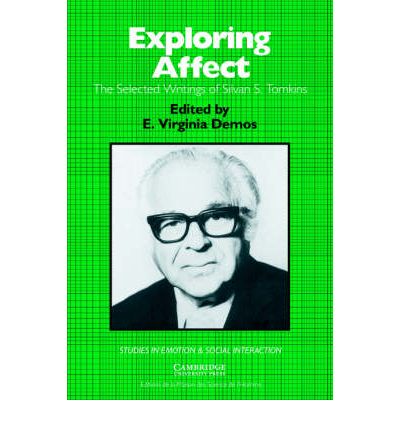 From the
publisher: "Silvan Tomkins was one
of the most influential theorists on emotion and emotional expression. Over
a period of 40 - some years - until his death in 1991 - he developed a set
of original, important ideas about the nature of affect and its relationship
to cognition and personality. Tomkins dealt with fundamental questions in a
fresh and provocative way, establishing affect as a separate, biological
system, and providing compelling data on discrete affect expressions.
Several years before his death, Professor Tomkins agreed to bring his papers
(unpublished and published) together into Exploring Affect for Cambridge
Studies in Emotion and Social Interaction. He worked with Paul Ekman and
Klaus Scherer to develop a structure for the book that would synthesize his
theory of emotion. Unfortunately, he died before he was able to complete the
process. Virginia Demos, who knew Professor Tomkins well, took on the
enormous task of compiling the papers and writing connective material for
the book. This volume of Tomkins selected writings on affect brings together
his works of four decades and makes them available at a more receptive time
in the field. It is a treasure trove of provocative, insightful and relevant
ideas."
From the
publisher: "Silvan Tomkins was one
of the most influential theorists on emotion and emotional expression. Over
a period of 40 - some years - until his death in 1991 - he developed a set
of original, important ideas about the nature of affect and its relationship
to cognition and personality. Tomkins dealt with fundamental questions in a
fresh and provocative way, establishing affect as a separate, biological
system, and providing compelling data on discrete affect expressions.
Several years before his death, Professor Tomkins agreed to bring his papers
(unpublished and published) together into Exploring Affect for Cambridge
Studies in Emotion and Social Interaction. He worked with Paul Ekman and
Klaus Scherer to develop a structure for the book that would synthesize his
theory of emotion. Unfortunately, he died before he was able to complete the
process. Virginia Demos, who knew Professor Tomkins well, took on the
enormous task of compiling the papers and writing connective material for
the book. This volume of Tomkins selected writings on affect brings together
his works of four decades and makes them available at a more receptive time
in the field. It is a treasure trove of provocative, insightful and relevant
ideas."
While I haven't personally used the following book in my own work, it has been recommended to me:
-
Restorative Schools, Restorative Communities Janet Clark, Speechmark, 2012 Amazon
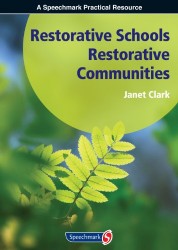 From the
publisher: "This book is aimed at
all professionals interested in developing restorative approaches in their
school, from those considering starting to those who have implemented
programmes and want to evaluate and improve their practice. The content
includes a brief background to its introduction in the UK in the 1990s and
the influence of the pioneering work of colleagues in Australia and New
Zealand. From the earliest emphasis on restorative justice, the book
outlines the wider educational model of restorative approaches used in
today's schools. The book guides the reader through the stages of evaluating
their current restorative practice with a suggested framework of how to get
started and how to evaluate progress, illuminated by case studies from
across the UK. Areas such as staff training and development are considered,
as well as how to involve young people. The role of the wider community and
key players are explored, their involvement in schools and how schools in
turn can work within the community. Importantly, the book identifies the
need to include parents and careers as a crucial factor for embedding
restorative practice in the school and community setting. The case studies
show how schools' behaviour policies have moved from a punitive and blameful
culture to one of repairing relationships and solving problems. They also
highlight improvements in the school climate, including increased attendance
and a fall in fixed term exclusions. This practical book is suitable for
both primary and secondary schools. The accompanying CD includes an
introductory Power Point for staff as well as capable resources including
checklists, action plans, referral forms, information guides, evaluation
sheets and exemplar contracts."
From the
publisher: "This book is aimed at
all professionals interested in developing restorative approaches in their
school, from those considering starting to those who have implemented
programmes and want to evaluate and improve their practice. The content
includes a brief background to its introduction in the UK in the 1990s and
the influence of the pioneering work of colleagues in Australia and New
Zealand. From the earliest emphasis on restorative justice, the book
outlines the wider educational model of restorative approaches used in
today's schools. The book guides the reader through the stages of evaluating
their current restorative practice with a suggested framework of how to get
started and how to evaluate progress, illuminated by case studies from
across the UK. Areas such as staff training and development are considered,
as well as how to involve young people. The role of the wider community and
key players are explored, their involvement in schools and how schools in
turn can work within the community. Importantly, the book identifies the
need to include parents and careers as a crucial factor for embedding
restorative practice in the school and community setting. The case studies
show how schools' behaviour policies have moved from a punitive and blameful
culture to one of repairing relationships and solving problems. They also
highlight improvements in the school climate, including increased attendance
and a fall in fixed term exclusions. This practical book is suitable for
both primary and secondary schools. The accompanying CD includes an
introductory Power Point for staff as well as capable resources including
checklists, action plans, referral forms, information guides, evaluation
sheets and exemplar contracts."
Bookstores
Graeme George in Class
